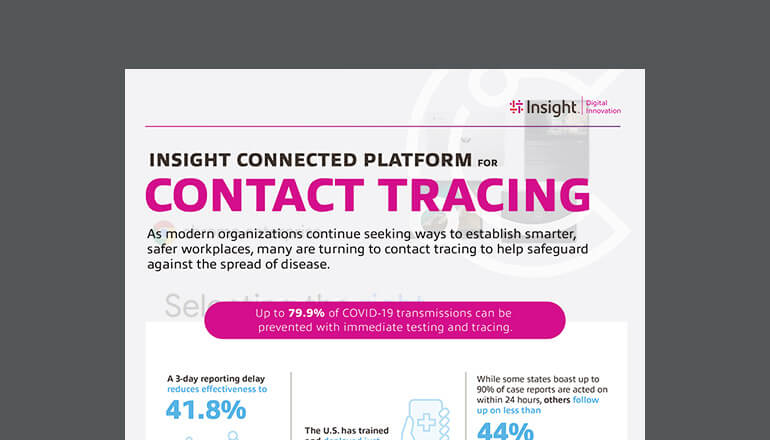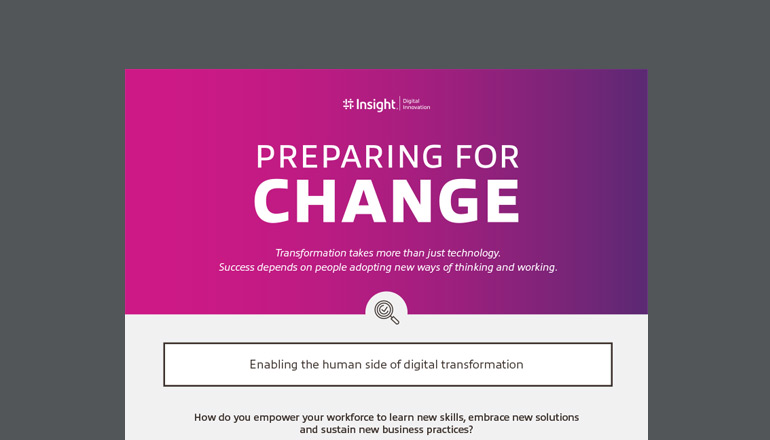Infographic text included for screen readers:
Guide to Identifying Business Challenges
Before investing in a digital transformation initiative, you’ll need to identify, analyze and clearly define the core business needs that a new technology or process will address.
Use these strategies to help your team identify where digital transformation will have the greatest potential impact on your business.
Start at the source.
The top drivers for digital transformation include:
- 51% Growth opportunities
- 41% Competitive pressure
- 28% CIOs
Whether it’s a market disruption or C-level directive, the broader catalyst for change is often a good indicator of where underlying challenges may exist.
- Is transformation being driven from within? Is there a new need or a new idea?
- Is there competitive pressure or a source of external disruption?
- Review your organization’s annual goals. Do these reflect or align with existing challenges?
- What operational challenges have been identified in the past?
Get a view from the ground up.
Although 90% of C-suite executives believe their company pays attention to people’s needs when introducing new technology, only 53% of employees agree.
Without the end-user perspective, it can be easy to miss the mark when it comes to adding or changing products or services. Conduct surveys or interviews with customers and employees to gain a better understanding of the market need.
- What processes, approaches or technologies are working? What’s not working?
- Where do frustrations or complaints typically occur for employees or customers?
- Where do bottlenecks, siloes or gaps in visibility exist?
Dig into the data.
More than 59% of businesses are currently using some method of collecting business insights.
Consider which metrics you have available which can help to pinpoint inefficiencies, defects or other challenges with your offerings. Which new areas will you need to measure in order to demonstrate Return on Investment (ROI)?
- By which metrics are you currently doing well? Where could they be doing better?
- Are there dramatic shifts or anomalies that may indicate an underlying change?
- Which areas or departments have the most to gain from adopting new technologies and new ways of working?
- Which business metrics could be used as benchmarks to measure improvement before and after your initiative has been put into place?
Get to the root of the problem.
Look for commonalities in the data as well as feedback from customers and employees to identify underlying issues behind product or service-related complaints.
- Is there a physical or technical cause? Are there systems or equipment in need of optimization?
- Is there a human cause? Are there areas where lack of knowledge or accuracy are an issue?
- Is there an organizational cause? Are there policies or processes that are reducing efficiency?
Tip: According to the principles of root cause analysis, it takes at least 5 “whys” to trace a problem back to its true source. Use this technique to ensure you recognize and address the core issue — not just the symptoms.
Do your research.
Top priorities for today’s digital innovation initiatives include:
- 52% improving operations and business processes
- 47% improving customer experiences and relationships
- 39% making employees more productive
- 38% developing new products and services
In evaluating a transformation initiative, take some time to consider the greater business landscape, including market trends, competitors and customers.
- What do experts and research reports predict for your industry or market? What challenges may be on the horizon?
- What is the current climate of your marketplace or industry?
- What challenges are other organizations in your industry experiencing?
- How are they leveraging new technologies or processes to solve these issues?
Common business challenges
- Foundational infrastructure for data-driven solutions
From multicloud infrastructure to the intelligent edge, these foundational technologies need to be addressed first and foremost in order to support the critical workloads and applications your organization relies on every day. - Changing expectations from modern employees and consumers
Today’s organizations need to empower employees to deliver more intelligent, personalized experiences, anywhere at any time. Digital transformation strategies in this area may include connected devices, intelligent applications, augmented experiences and more. - Visibility into Key Performance Indicators (KPIs)
If identifying inefficiencies within your organization is a challenge in itself, you may benefit from a transformation initiative focused on leveraging actionable intelligence to drive more effective decision-making through data unification or real-time alerts. - Digital tools and process optimization for greater efficiency
Business challenges in this area often require a transformation focused on empowering employees with more effective ways to get things done — from smart devices and Robotic Process Automation (RPA) to embracing Agile best practices. - Knowledge and proficiency with products or processes
If keeping employees and customers educated on operations or offerings is a challenge, transformation efforts focused on enablement through intelligent apps, chatbots, AR or VR can improve employee effectiveness and customer satisfaction. - Competitive disruption and an ever-changing business landscape
Even the most technically savvy organizations need to continuously innovate to stay competitive. Technologies like AI and predictive maintenance can help to maximize operational efficiency and give your organization a critical edge.
70% of organizations are currently working on a digital transformation strategy. How will you transform?
Insight. (2019, May 6). Insight Technology Trends 2019 Report. Insight.com.
PWC. (Oct. 2018). Consumer Intelligence Report Series.
Solis, B. (2019). The State of Digital Transformation. Altimeter.
Tech Pro Research. (Aug. 2017). How Big Data Is Driving Business Insights In 2017.
Tech Pro Research. (2018). Digital Transformation: A CXO’s Guide. TechRepublic.



